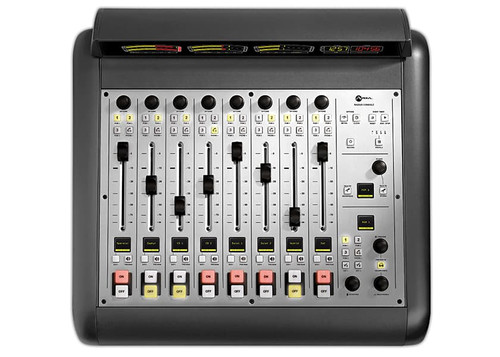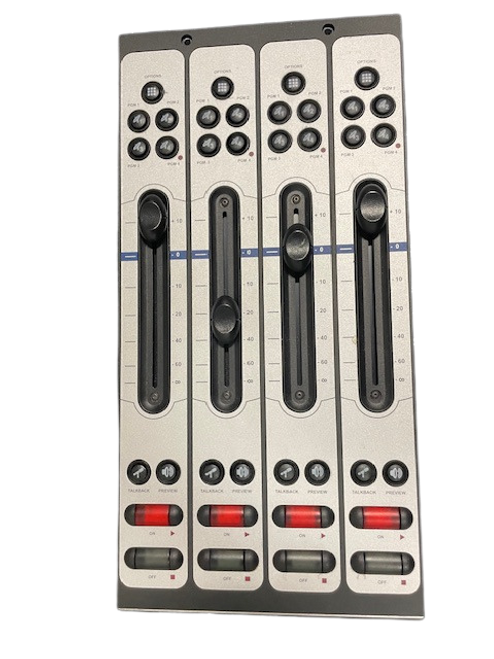Overview
The Axia® iQ radio console system can be used to build custom consoles of sizes from 8 to 24 faders. A basic system consists of one iQ 8-Fader Main Frame and one QOR.32 integrated console engine, a DSP- based mixing engine which also incorporates analog and digital audio I/O, GPIO and a custom, zero- configuration Ethernet switch. Faders and control capabilities can be expanded by adding one or more iQ Expansion Frames (up to a maximum of 3 frames per console installation). iQ console frames may be placed on top of desk surface, or mounted drop-in style. Multiple frames may be physically joined if desired.
iQ operates as a standalone console, but can also connect to Axia networks. The iQ mixing surface plugs into the QOR.32 engine using a single cable. Setup couldn’t be simpler: connect the iQ control surface to the QOR.32, add audio inputs using CAT-5, perform some fast Web-based configuration, and your iQ system is ready to broadcast. It really is that simple!
iQ features 3 dedicated stereo Program buses, plus a stereo Utility bus that can be used for phone calls, off-air recording, or as a fourth Program bus. Automatic mix-minus is provided on each fader, plus talkback functions, one-button off-air Record Mode, Show Profile functions for instant recall of up to 4 pre-defined console “snapshots”, high-resolution OLED program meters switchable between VU and PPM metering styles, OLED option and source name displays on each fader strip, Studio and Control Room monitor controls. Add redundant power to your iQ system with the Axia Console Power Supply. This single-cable connection to the QOR.32 console engine provides backup power with automatic switching.
Features
-
Configurable from 8 to 24 faders, each with instant access to any source.
-
Proven surface-and-core architecture separates control from mixing processes. No audio passes directly through iQ; all mixing and processing is performed in the QOR.32 Integrated Console Engine – so studio “accidents” don’t turn into off-air events.
-
Software upgrade for QOR.32 integrated console makes iQ AoIP console AES67-compliant.
-
Assign any type of source to any channel with a twist of the Options knob.
-
Four main stereo outputs (Program-1 through Program-4).
-
Built-in three-band per-source EQ.
-
Alpha-numeric OLED displays below each fader always show the current audio source, and, when the Options knob is pressed, offer fast adjustment of fader gain trim, voice EQ, pan and balance, phase correction and other features without panel clutter or intimidating controls.
-
Channel-input confidence meters assure talent of audio presence before taking sources to air.
-
Each fader’s context-sensitive Soft key can be used to activate talkback, start delivery system events, or perform other special functions.
-
Every fader has a stereo Preview (“cue”) function, with a unique interlock system for fast cuing of multiple sources.
-
Smooth, long-life 100mm. conductive-plastic faders resist dirt and contamination.
-
Reconfigurable CR monitor section with direct-selection of Program buses and reassignable buttons that allow instant monitoring of external sources.
-
An additional monitor section provides monitor volume, source selection and talkback controls for an associated air studio.
-
Flexible talkback system lets board op talk to studio guests or any Phone or Codec source with an associated backfeed.
-
Up to 8 automatic mix-minuses may be used simultaneously for phones, remote talent, etc.
-
Unique Record Mode enables one-button setup of record mixes for phone bits or off-air interviews.
-
High-resolution OLED displays provide responsive, readable VU or PPM metering styles. Displays can be switched to display 2, 3 or 4 meters at once.
-
Precision event timer that can be operated manually or triggered by starting pre-selected sources.
-
Time-of-day clock can be synchronized to network time using NTP.
-
Four custom Show Profile “snapshots” can be saved to instantly recall frequently-used console setups –
useful to quickly prepare for interview segments, music-intensive programming, call-in talk shows, etc. -
All functions can be accessed remotely for configuration, management and diagnostic purposes using any standard Web browser.
-
Multiple iQ frames can be joined to produce a single, large control surface, or operated separately if desired to suit studio design.
-
Optional Telco Expansion frame provides direct, on-the-console control of matching Telos® iQ6 six- line telephone system, or other Telos talkshow systems. High-resolution OLED displays use exclusive Telos Status Symbols for instant call status information. Includes a Dump key to trigger user-supplied profanity delay unit using GPIO closures.
-
Easy-to-deploy QOR.32 integrated console engine includes console CPU and power supply, DSP mixing engine, custom Ethernet switch with 6 Livewire® ports and 2 Gigabit ports for studio networking, 16 analog inputs and 8 analog outputs, 2 AES inputs and 2 AES outputs, 4 Mic inputs with switchable Phantom power, and 8 GPIO ports for machine control. I/O can be expanded using Axia Audio xNodes.
-
Integrated zero-configuration network switch is custom-designed for broadcasting — no switch setup required.
-
QOR.32’s built-in Ethernet switch supports Simple Networking, allowing up to 4 iQ consoles to be daisy-chained without the need for a separate core switch.
-
Fan-free, convection-cooled power supply for noiseless in-studio operation.
-
Optional backup Axia Console Power Supply with automatic failover for complete peace of mind.
-
Configurable network gateway allows loading of networked as well as local audio sources while simultaneously exporting audio streams for network use elsewhere. Gateway can be configured for
12-in, 4-out or 8-in, 8-out modes. - Automixer available on all channels.
In Depth
Control at the Click of a Mouse. Easy Installation. Fast Configuration. Intuitive Operation.
For today’s broadcast engineer, there aren’t enough hours in the day. You’re looking for a console that makes the most of your resources. One that installs quickly, with a minimum of fuss. One that works smart, with features that help talent to do smoother, more error-free shows. One that’s perfectly happy in a standalone studio — but that also connects quickly and easily to a larger studio network.
iQ is the console you’re looking for. More than just a pretty face, iQ is a broadcast console with mixing engine, analog and AES audio I/O, Livewire audio connections, machine-control logic and a zero-configuration built-for-broadcast Ethernet switch, all rolled into one easy-to-deploy package. Connect the iQ control surface to the QOR.32 integrated console engine with just one cable. Then add audio inputs using CAT-5, perform some fast Web-based configuration and, presto! your new iQ console is ready to broadcast. Optional Axia Console Backup Power Supply adds redundant power to your iQ system for complete peace of mind.
Thanks to all those built-in goodies, iQ is the perfect self-contained, standalone console for an individual studio. But should you wish to expand and network with other studios, iQ can grow with you. Simple Networking lets you daisy-chain up to four QOR.32 engines without the need for an external Ethernet switch. You can add iQ expansion frames to create consoles as large as 24 faders. Other optional frames add control for Telos telephone systems and GPIO routing functions to the console.
More smart stuff: iQ remembers. Four Show Profile memory positions let you set, save and recall snapshots of console settings for later use. High-resolution Organic LED meters (bright, high-resolution displays that are bright and legible, even under direct lighting) offer switchable VU or PPM metering styles, and the ability to meter two, three, or all four buses at once.
There are also OLED displays on every fader that provide source assignments, pan & balance settings, fader options and more — which means no additional computer monitors or mice to clutter up your studio. The display can also work with the Soft Keys just below to trigger GPIO events, step automation events, and adjust source input options.
iQ saves your studio furniture, too. Its desktop design lets you place it atop any solid surface — no templates to decipher or countertops to cut (unless you really want to). Since iQ only requires a single cable to connect control surface to mixing engine, even cable access holes can be small and unobtrusive. And iQ lets you choose between freestanding or contiguous console designs: you can easily join iQ expansion frames into one unit, or leave them separate to deploy a split-console design.
Like all Axia consoles, iQ is over-engineered for long life. It’s built with sturdy, premium materials, to withstand even the beatings a weekend overnight jock can give. It’s got sturdy, machined aluminum frame construction, LED button lighting, long-life conductive-plastic faders, and anodized – not painted! – surfaces with laser-etched markings that can’t ever rub off. But the most clever thing about iQ might just be its price. A 16-fader iQ costs about half what you’d expect to pay for a console with all these features. Now that’s pretty smart, don’t you think?
iQ System Components
Like all Axia systems, iQ is customizable and scalable. The QOR.32 integrated console engine contains the console’s mix engine, CPU, power supply and 32 audio I/O connections, and supports console sizes from 8 to 24 faders. Start with an eight-fader iQ Main Frame, then add expansion frames with more faders and capabilities to tailor iQ to your studio’s needs. Gigabit Ethernet lets you connect to a larger Axia network; Simple Networking lets you daisy-chain up to four QOR.32 without the need for an external Ethernet switch.
iQ Main Frame
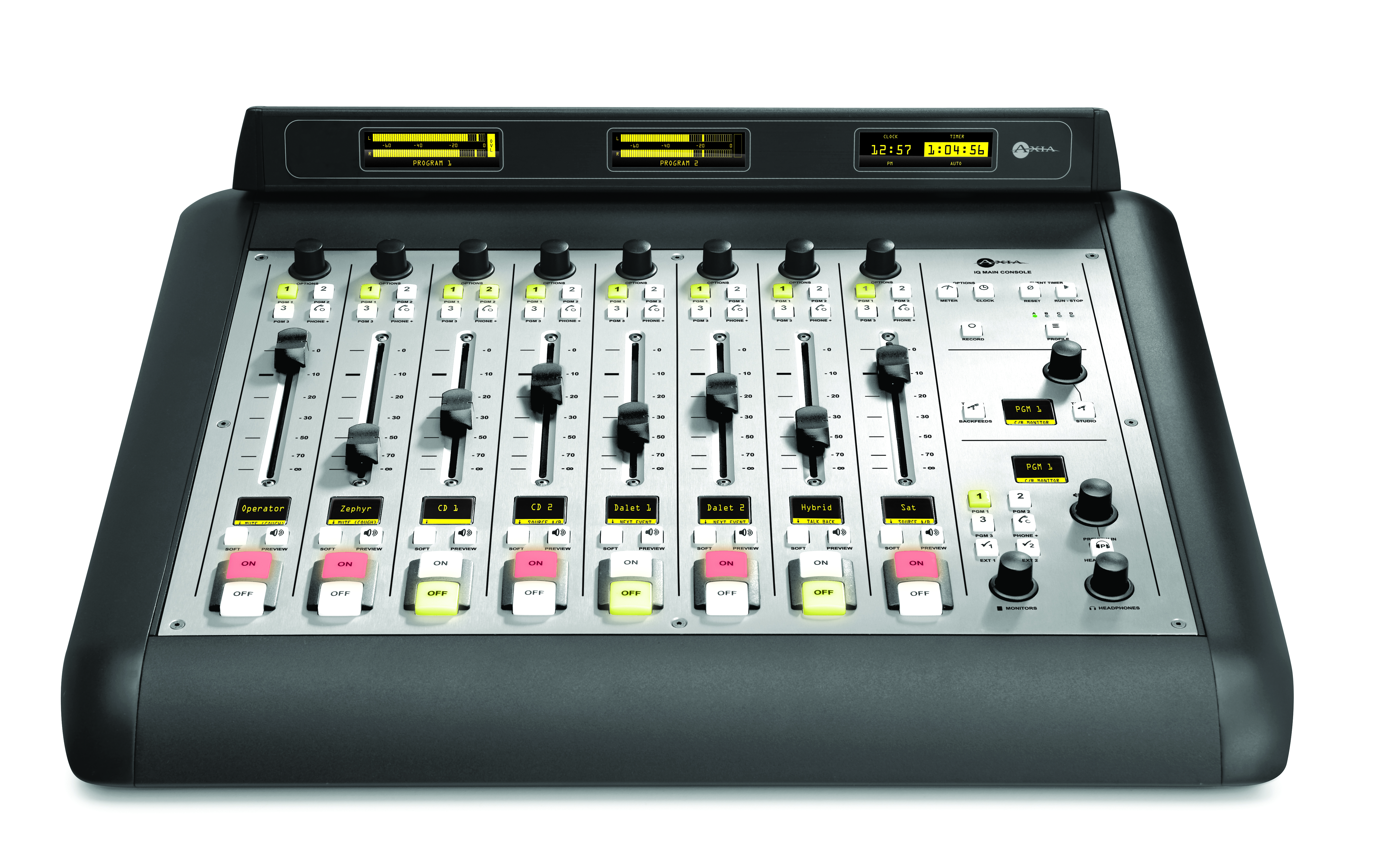
The heart of your iQ console; can be installed as a standalone console or connected to an Axia studio network. Has three dedicated stereo Program buses, plus a stereo utility bus that can be used for phone calls, off-air recording, or as a fourth Program bus, eight faders, automatic per-fader mix-minus, high- rez OLED program meters and channel displays, Studio and Control Room monitor controls and an integrated Talkback system. For bigger consoles, add one or two iQ expansion frames to build boards of up to 24 faders. Flexible mounting system allows desktop, drop-in and even rack-mounted operation.
8-Fader Expansion Frame (Sold Separately)
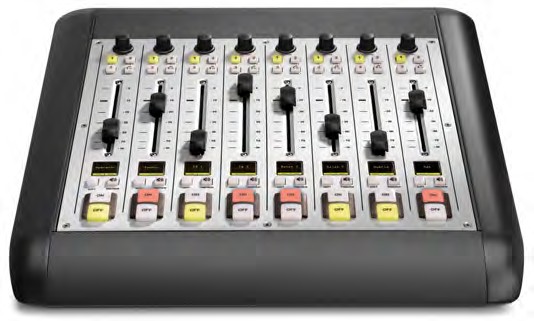
The iQ 8-Fader frame doubles the size of your iQ instantly. It’s simple to expand the capacity of iQ consoles, even after they’ve been in service, so you can easily grow your iQ system; expansion frames plug right into the QOR.32 integrated console engine. Like all iQ frames, the 8-Fader expansion comes equipped with Axia’s rugged, anodized machined-aluminum surface, conductive-plastic faders, aircraft- quality switches and LED button lighting. Can be physically joined to Main Frame or left separate.
6-Fader Expansion Frame with User Keys (Sold Separately)
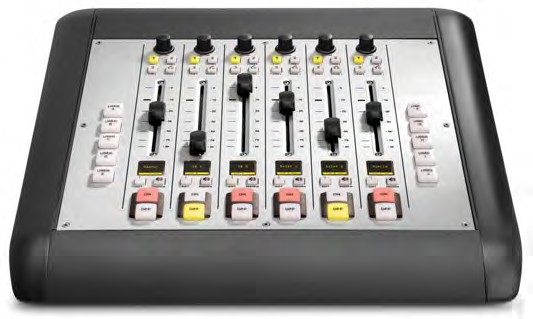
Put machine control and GPIO-triggered routing commands at your operators’ fingertips with this iQ expansion frame. In addition to the six additional faders, 10 User Keys can be software-mapped to control audio delivery systems, send contact closures or route GPIO commands to studio devices.
6-Fader Telco Expansion Frame (Sold Separately)
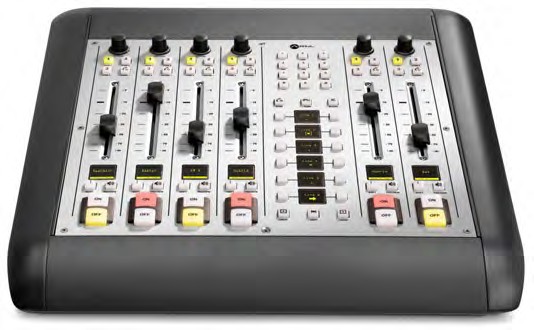
Puts integrated phone system control right where it belongs: on the console, to help eliminate distractions and errors. Along with six silky-smooth conductive-plastic faders, this frame includes on- the-board hybrid controls for the matching Telos iQ6 six-line telephone hybrid (it works with other Telos phone systems, too). The learning curve is low: exclusive Telos Status Symbols readouts on sharp-as-a- tack OLED displays, along with familiar twin hybrid controls, make easy work of busy call-in segments.
QOR.32 Integrated Console Engine (Sold Separately)
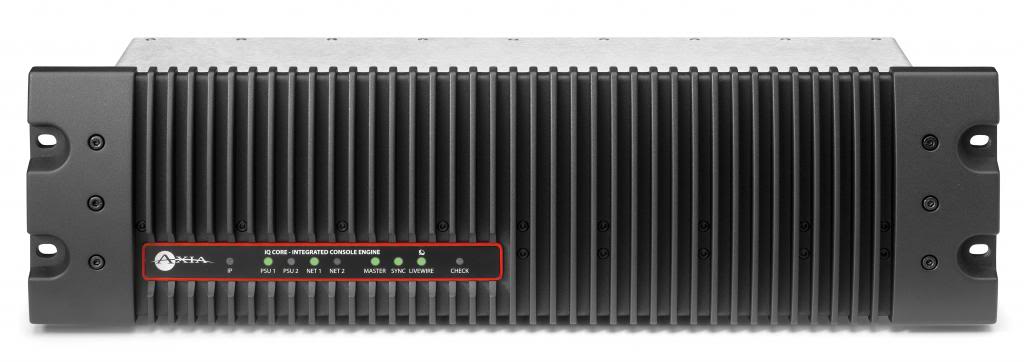
The QOR.32 integrated console engine is a DSP-based mixing engine with onboard I/O, GPIO, console power supply and custom-built, configuration-free Ethernet switch. You’ll find plenty of I/O, including 4 mic inputs with selectable Phantom power, 16 analog inputs, 2 AES/EBU inputs, 8 Analog outputs, 2 AES/EBU outputs, 8 GPIO machine-control logic ports (each with 5 opto-isolated inputs and 5 outputs), and that powerful integrated Ethernet switch with 6 Livewire 100BASE-T ports (4 with PoE), 2 Gigabit ports (RJ-45 & SFP), and 4 CANBus ports for console expansion. Sure, that’s plenty of I/O, but if you need more you can instantly add it just by plugging in Axia xNodes. QOR.32 is convection-cooled for utterly silent, fan-free operation.
Axia Console Backup Power Supply (Sold Separately)

Add redundant power to your iQ system! Single-cable connection to QOR.32 console engine provides backup power with automatic switching. Auto-sensing power supply, 100VAC to 240VAC, 50 Hz to 60 Hz. 250 Watts. Rackmount, 2RU.
Specifications
QOR.32 Connections
-
Microphone Inputs: 4x balanced XLR-F, with selectable Phantom power
-
Analog Inputs: 16x RJ-45, StudioHub+ standard.
-
Analog Outputs: 8x RJ-45, StudioHub+ standard.
-
AES/EBU Inputs: 2x RJ-45, StudioHub+ standard.
-
AES/EBU Outputs: 2x RJ-45, StudioHub+ standard.
-
GPIO: 8x DB-15
-
Livewire:
-
4x 100BASE-T with PoE, RJ-45
-
2x 100BASE-T, RJ-45
-
2x 1000BASE-T, RJ-45
-
2x Gigabit, SFP (Small Form Pluggable)
-
-
Console Frame Connections: 3x, 6-pin “latch and lock” style
-
Accessory Connections: 1x, 6-pin “latch and lock” style
Microphone Preamplifiers
-
Source Impedance: 150 Ohms
-
Input Impedance: 4 k Ohms minimum, balanced
-
Nominal Level Range: Adjustable, -75 dBu to -20 dBu
-
Input Headroom: >20 dB above nominal input
-
Output Level: +4 dBu, nominal
Analog Line Inputs
-
Input Impedance: 20 k Ohms
-
Nominal Level Range: Selectable, +4 dBu or -10dBv
-
Input Headroom: 20 dB above nominal input
Analog Line Outputs
-
Output Source Impedance: <50 Ohms balanced
-
Output Load Impedance: 600 Ohms, minimum
-
Nominal Output Level: +4 dBu
-
Maximum Output Level: +24 dBu
Digital Audio Inputs And Outputs
-
Reference Level: +4 dBu (-20 dB FSD)
-
Impedance: 110 Ohm, balanced (XLR)
-
Signal Format: AES-3 (AES/EBU)
-
AES-3 Input Compliance: 24-bit with selectable sample rate conversion, 20 kHz to 216kHz input sample rate capable.
-
AES-3 Output Compliance: 24-bit
-
Digital Reference: Internal (network timebase) or external reference 48 kHz, +/- 2 ppm
-
Internal Sampling Rate: 48 kHz
-
Output Sample Rate: 48 kHz
-
A/D Conversions: 24-bit, Delta-Sigma, 256x oversampling
-
D/A Conversions: 24-bit, Delta-Sigma, 256x oversampling
-
Latency <3 ms, mic in to monitor out, including network and processor loop
Frequency Response
- Any input to any output: +0.5 / -0.5 dB, 20 Hz to 20 kHz
Dynamic Range
-
Analog Input to Analog Output: 102 dB referenced to 0 dBFS, 105 dB “A” weighted to 0 dBFS
-
Analog Input to Digital Output: 105 dB referenced to 0 dBFS
-
Digital Input to Analog Output: 103 dB referenced to 0 dBFS, 106 dB “A” weighted
-
Digital Input to Digital Output: 125 dB
Equivalent Input Noise
- Microphone Preamp: -128 dBu, 150 Ohm source, reference -50 dBu input level
Total Harmonic Distortion + Noise
-
Mic Pre Input to Analog Line Output: <0.005%, 1 kHz, -38 dBu input, +18 dBu output
-
Analog Input to Analog Output: <0.008%, 1 kHz, +18 dBu input, +18 dBu output
-
Digital Input to Digital Output: <0.0003%, 1 kHz, -20 dBFS
-
Digital Input to Analog Output: <0.005%, 1 kHz, -6 dBFS input, +18 dBu output
Crosstalk Isolation, Stereo Separation And CMRR
-
Analog Line channel to channel isolation: 90 dB isolation minimum, 20 Hz to 20 kH
-
Microphone channel to channel isolation: 80 dB isolation minimum, 20 Hz to 20 kHz
-
Analog Line Stereo separation: 85 dB isolation minimum, 20Hz to 20 kHz
-
Analog Line Input CMRR: >50 dB, 20 Hz to 20 kHz
-
Microphone Input CMRR: >50 dB, 20 Hz to 20 kHz
Audio Processing
-
Mic Equalizer (applicable to up to 6 faders)
-
Frequency Bands: 20Hz to 320Hz, 125Hz to 2KHz, 1.25KHz to 20KHz.
-
Cut/Boost range on each band: -25dB to +15dB.
-
Q-factor: Automatic - bandwidth varies based on amount of cut or boost.
Power Supply AC Input, QOR.32 with iQ Console
-
Auto-sensing supply, 100VAC to 240VAC, 50 Hz to 60 Hz, IEC receptacle, internal fuse
-
Power consumption: 100 Watts
Operating Temperatures
- -10 degrees C to +40 degrees C, <90% humidity, no condensation
Dimensions
-
iQ Main Frame 20.5” x 19” x 4.5” (desktop to meter bridge)
-
iQ Expansion Frames 17.5” x 18.25” x 3” (desktop to tallest control)
Regulatory
North America: FCC and CE tested and compliant, power supply is UL approved.
Europe: Complies with the European Union Directive 2002/95/EC on the restriction of the use of certain hazardous substances in electrical and electronic equipment (RoHS), as amended by Commission Decisions 2005/618/EC, 2005/717/ EC, 2005/747/EC (RoHS Directive), and WEEE.








